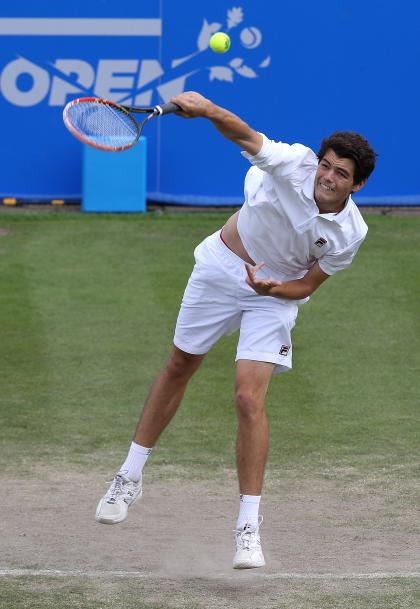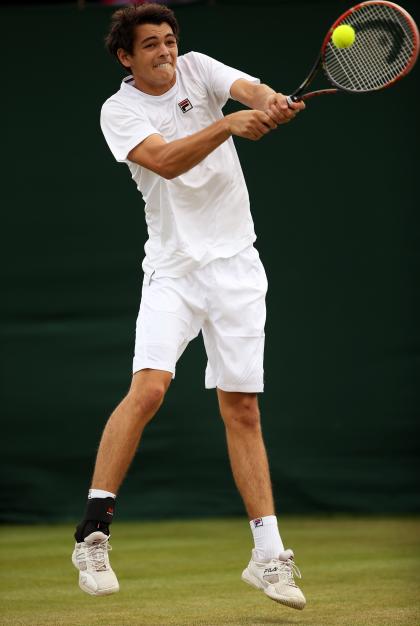Taylor Harry Fritz may be the rising star American men's tennis has lacked
Not long after he arrived in Florida to train with the best American tennis players in his age group two years ago, Taylor Harry Fritz came to a jarring realization.
He wasn't quite as good as he thought he was.

More from the 'Coming Attractions' Series on sports phenoms:
• June 22: Parents of world-class athletes reveal secrets to raising a superstar
• June 23: Teenager Kaylin Whitney hailed as America's next great sprinter
• June 30: Linebacker has 11 scholarship offers before starting high school
• July 2: DeAndre Ayton's long road from Bahamas project to basketball's No. 1 prospect
• July 7: Taylor Harry Fritz may be the rising star American men's tennis has lacked
Fritz struggled to find a single player at the camp he could beat, an unsettling experience for a talented teenager accustomed to success coming easily on the tennis court. Winning youth tournaments had never required Fritz to devote as much time to the sport as many of his peers did, but at last the son of two former professional tennis players had firsthand evidence his long-term goals weren't attainable relying on natural ability alone.
"There were 16 of us at that camp, and I was without a doubt the worst one there," Fritz said. "I realized that if I wanted to be a pro tennis player, I had a long way to go. I had to start working harder."
Being force-fed a heaping helping of humility turned out to be more of a springboard than a setback for Fritz because it forced him to drastically alter his approach. A newly dedicated Fritz gave up the other sports he played to focus exclusively on tennis, cut out unhealthy foods from his diet and committed to spending more time doing strength and conditioning work at the gym or hitting balls on the practice court.
Within a year, Fritz reached the semifinals of junior Wimbledon. Within 18 months, Fritz upset the world's No. 1 ranked junior player on his best surface. Last month, the 17-year-old finished runner-up at the junior French Open, a result that enabled Fritz to become the first American male in a decade to claim the top spot in the world junior rankings.
Fritz's dizzying ascent has caught the attention of high-level agents itching to land the player who could someday rejuvenate American men's tennis. They've promised Fritz and his parents they can deliver lucrative racket, shoe and apparel endorsements right away, especially if the 6-foot-4 San Diego native were to boost his value even further this week by winning junior Wimbledon.
The idea of Fritz turning pro at 17 worries his parents because they know the grueling schedule companies he'd endorse would want him to play and they fear he might not be strong enough yet to withstand the pounding. Fritz's parents initially intended to send him to USC for at least a year before he turned pro, but his recent surge has forced them to consider an accelerated timetable.
"Taylor wants to turn pro this summer, and he's winning the battle," his father Guy Fritz said. "The money is there. The agents are there. But I'm torn because he needs more time to get stronger. He's had some great results but he has been on a limited schedule. You go on tour and sign a contract and now you have to play a certain amount of weeks. I'm trying to protect him from going through injuries because I think he has a chance to become a top pro."
Fritz's emergence as an elite prospect comes at a time when American tennis is desperate for a new leading man.
Twenty years ago, Pete Sampras and Andre Agassi were No. 1 and 2 in the world, three other American men were fixtures among the top 20 and the U.S. was on its way to confirming its status as a juggernaut by defeating Russia in the Davis Cup finals. Today, the U.S. hasn't produced a viable grand slam contender since Andy Roddick was in his prime, nor does it have a single player ranked higher than 30-year-old John Isner at No. 17.
Why has American men's tennis sunk to once-unfathomable depths? It's partially a product of the globalization of the game. Top male athletes in more countries across Europe, Asia and South America are pursuing tennis, as evidenced by the presence of players from 12 different nations in the current top 15. Conversely, top American male athletes typically opt for football, basketball or other sports more visible in this country.

The pressure to fill the void left by Sampras, Agassi and Roddick has stymied a handful of promising young Americans. Once-heralded juniors Sam Querrey and Donald Young are particularly glaring examples as neither has managed to dethrone an aging Isner as top-ranked American or advance past the fourth round at a grand slam.
One advantage Fritz has over his predecessors is he won't have to shoulder the burden of saving American tennis alone. First-year pros Frances Tiafoe and Stefan Koslov both have considerable talent and Fritz, Michael Mmoh and Riley Opelka headline a group of five other rising U.S. teens ranked in the top 20 of the current world junior rankings.
"I see much more potential in this group than some previous ones, but it's kind of like a stock," retired American tennis player Brad Gilbert said. "Sometimes potential doesn't develop. Other times it turns out better than you think. But I'm very hopeful this group will deliver. I'd be shocked if we didn't get three guys from this group to at least be top 25."
Of that group of young guns, Fritz in particular has caught Gilbert's eye.
Fritz has long boasted a booming forehand and a powerful serve that exceeds 130 miles per hour, but lately he has solidified his backhand to the point that he makes few errors off it and can use it to construct points. Gilbert likened Fritz to a young Todd Martin, the 6-foot-6 former Australian Open and US Open finalist who climbed as high as No. 4 in the world back in 1999.
"Taylor reminds me of him a little bit because of his size and ability to hit the ball," Gilbert said. "Taylor has a world of ability and he has made a lot of progress the last couple of years. He's certainly not there yet, but I think he has a chance to be that type of player."
It's no surprise Gilbert sees that kind of potential in Fritz considering his parents' tennis background.
Kathy May Fritz cracked the top 10 in the world and reached three grand slam quarterfinals in 1977 and 1978. Guy Fritz also played professionally in the 1970s before enjoying greater recent success as a renowned tennis coach in the San Diego area.
Both Fritz's parents were hopeful he'd embrace tennis given his bloodlines, but their son preferred soccer, tee-ball and basketball as a young kid. Only after Guy Fritz employed some clever psychology did seven-year-old Taylor agree to make time to play tennis too.
Desperate to coax his son into giving tennis a try without forcing him into it, Guy began inviting a handful of Taylor's friends over to house twice a week for a free clinic in the backyard. Guy further baited the hook by organizing games of soccer and football for the boys on the lawn after the clinic was over.
"Taylor heard his friends having fun, so of course he came out to the backyard and wanted to join them," Guy said. "I told him, 'Well, Taylor, this is only for kids in the tennis clinic.' To make a long story short, by that night he asked to join the clinic."
Some tennis players excel on the practice court but crumble under pressure during matches. From a young age, Fritz was the exact opposite. He established himself as one of the San Diego area's best youth prospects by playing his best when something was at stake yet he seldom showed much interest in hitting balls or doing drills between tournaments.

One reason Fritz often tried to get away with practicing as little as possible was that his results suggested he didn't need more. He still soared to the top of the Southern California rankings for his age group as a 12-year-old, swept the singles and doubles crowns at the USTA national championships as a 14-year-old and breezed to a San Diego section singles title as a high school freshman.
Another reason Fritz spent less time on the tennis court than his peers was his reluctance to give up the many other sports he enjoyed. Fritz was savvy enough to realize tennis was the sport he had the best chance to play professionally, yet he saw no reason he shouldn't play basketball, soccer, baseball or lacrosse if it wasn't affecting his results.
"I was playing other sports, I was lazy, I had the worst diet, I barely practiced tennis or did any fitness at all, and yet I was still winning matches and having good results," Fritz said. "My thinking was as long as that continued, I had no reason to fully commit to tennis."
Of course that changed two years ago when Fritz traveled to the USTA Training Center in Florida and discovered other elite players with superior work ethics were passing him by. It was then that Fritz began the transformation that paved the way for his jaw-dropping rise through the junior ranks.
He became more self-motivated on the practice court and more disciplined about his nutrition. He also persuaded his parents to let him take online classes instead of attending his last three years of high school, a decision that enabled him to more top out-of-state and international tournaments.
"That was a really tough decision because he was always a really great student and he liked the social aspect of it too," Kathy May Fritz said. "I had always been against home schooling because I didn't think you got as good an education that way, but this was what he really wanted and we gave him the chance. We figured we could always put him back in high school if it didn't work out."
Fritz is on pace to graduate high school in January, which would give him the option of enrolling at USC for spring semester should he choose to go that route. Neither Fritz nor his parents have ruled that option out, but it's clear that's not the direction he's leaning.
Last month at Nottingham, Fritz received a wildcard into the draw and won an opening-round match in straight sets for his first-ever ATP tour victory. A week later at Wimbledon, Fritz got the chance to practice with Roger Federer, an idol of his.
The more milestones Fritz attains, the more he gets peppered with questions about whether he can one day emerge as the new face of American men's tennis.
"I try to just ignore it," Fritz said. "I don't want the hype going to my head or creating pressure. There's a lot of other guys that have the exact same expectations. We all push each other to become better tennis players."
The line of questioning may get tiresome for Fritz but it's also a reminder of how far he has come.
Two years ago in Florida, he couldn't find an opponent he could beat. Now there aren't many players his age in the world who can beat him.
Jeff Eisenberg is the editor of The Dagger on Yahoo Sports. Have a tip? Email him at daggerblog@yahoo.com or follow him on Twitter!


